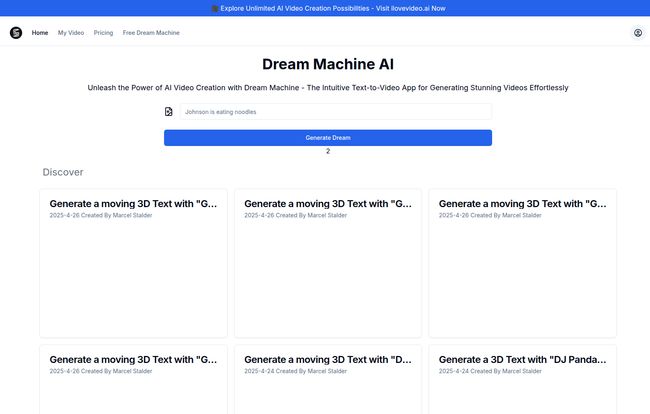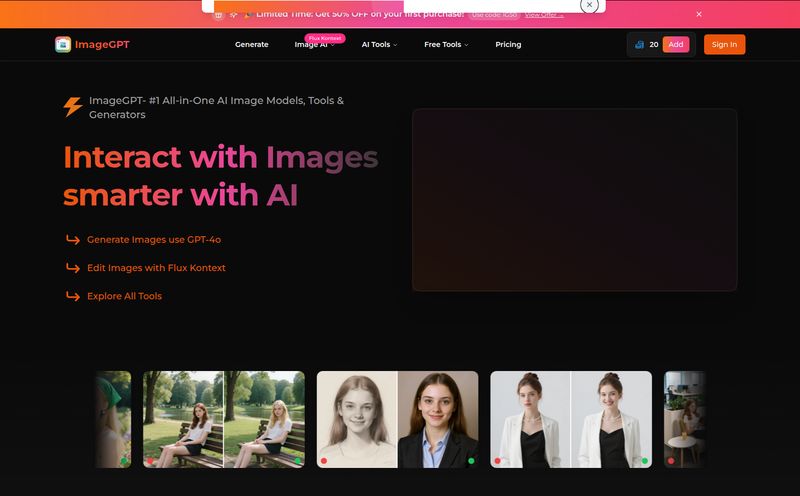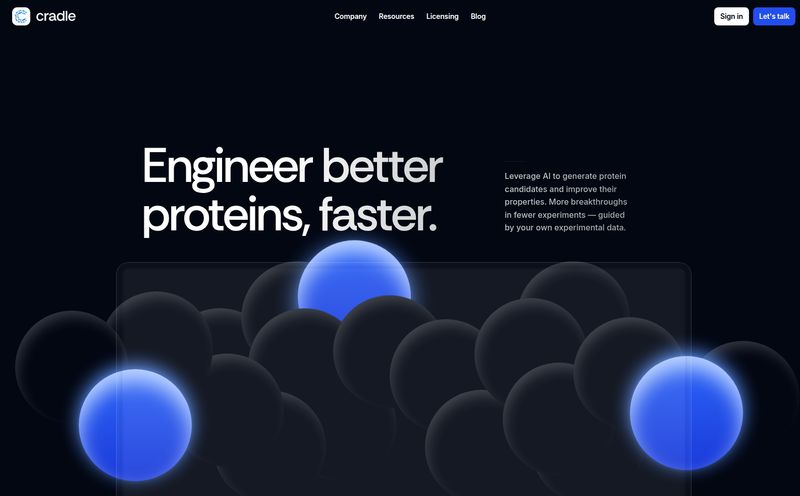Alright, let’s have a real chat. How many times in the last year have you seen a headline screaming about a new “Sora Killer” or a “game-changing AI video tool”? I’ve lost count. As someone who’s been neck-deep in SEO and content creation for years, you get a little… jaded. You see the flashy demos, the cherry-picked examples, and then you get your hands on the tool and it can barely animate a stick figure without it growing a third arm.
So when Luma AI’s Dream Machine started flooding my X (yeah, I still call it Twitter sometimes) feed, I rolled my eyes. Here we go again. But then I watched a few. And a few more. And pretty soon, my skepticism was replaced by that little flutter of excitement I haven’t felt since the early days of GPT-3. This one… this one felt different. My jaw kinda hit the floor.
It’s not just hype. It’s a genuinely accessible tool that’s putting some serious power into the hands of regular creators. So I dove in, spent some time with it, and now I’m here to give you the no-fluff, no-holds-barred rundown. What is this thing, how good is it really, and is it about to change your content workflow forever?
What Exactly is Luma's Dream Machine?
In the simplest terms, Luma’s Dream Machine is an AI model that creates short videos from text prompts or still images. You type “a corgi riding a skateboard through a cyberpunk city,” and a few minutes later, you get a 5-second video of exactly that. It’s part of a new wave of AI video generators, standing alongside big names like OpenAI’s Sora, Pika Labs, and RunwayML.
But here’s the kicker and the main reason we’re all talking about it: unlike Sora, which is still basically a mythical creature locked away in OpenAI's labs, Dream Machine is available for everyone to use right now. And for the time being, it’s free. That’s a massive deal. It’s taking this high-concept technology out of the theoretical and putting it directly into our hands.
My First Impressions: Hitting "Generate" and Holding My Breath
The interface is ridiculously simple. There’s a prompt box. That’s pretty much it. No complicated timelines or a million sliders to figure out. I’ve always believed the best tools are the ones that get out of your way, and this one does just that.
For my first test, I typed in something I thought would be a challenge: “A close-up shot of an old watchmaker, hands meticulously assembling a tiny brass gear, dust motes dancing in a single sunbeam.” I hit ‘Generate’, the system told me it would take about 120 seconds, and I went to grab a coffee, fully expecting to come back to a mess of melted hands and warped clock parts.
Two minutes later, I had a video. And it was… stunning. The lighting was moody, the hands were consistent (a notorious weak point for AI), and the camera had a subtle, cinematic drift to it. It wasn’t perfect, teh gear was a little wobbly on close inspection, but it was 90% of the way there. All from a single sentence. I was hooked.

Visit Dream Machine AI
The Good, The Bad, and The... AI-Weird
No tool is perfect, especially not in the wild west of generative AI. After dozens of generations, here’s my honest breakdown of where Dream Machine soars and where it stumbles.
Where Dream Machine Really Shines
The quality, for a free and public-facing tool, is frankly absurd. The character consistency is a huge standout. If you generate a person, they tend to look like the same person throughout the 5-second clip, which is a problem other platforms still struggle with. It also has an incredible grasp of camera movement. Prompts with “slow pan,” “dolly zoom,” or “crane shot” actually produce results that feel like they were directed by someone who knows what they’re doing. It’s this cinematic quality that really sets it apart from the more static, GIF-like results of older models.
And the speed! Getting a result in 120 seconds means you can iterate fast. Don’t like the first take? Tweak your prompt and go again. This rapid feedback loop is invaluable for creative work and a massive advantage over waiting 15-20 minutes per generation.
The Inevitable Quirks and Limitations
Now, let’s be real. It’s still AI. You’re going to get some weirdness. Every so often, an object will morph unnaturally or a background character will slide instead of walk. It's the digital equivalent of a Freudian slip, a little glimpse into the machine's bizarre subconscious.
It also struggles with text. If you try to generate a sign or a book cover, expect to get gibberish that looks like a forgotten alien language. This is a common problem across almost all image and video AI models, so it's not a unique flaw but something to be aware of. Also, complex physics or fast, precise movements can sometimes get a bit… floaty. It's better at moody, atmospheric shots than it is at a high-speed car chase, for instance.
Let's Talk About The Elephant in The Room: Pricing
“Free” in the tech world is usually a four-letter word that comes with an asterisk. Right now, Luma AI offers a generous number of free generations per month. This is almost certainly a launch strategy to get a flood of users, gather data, and build hype. And it’s working.
But what happens next? I've seen a few different potential pricing structures floating around, some on what look like third-party or clone sites, so there's a bit of confusion. However, based on the information I could dig up that seems most credible, future paid plans might look something like this:
| Plan Tier | Potential Monthly Price | Key Features |
|---|---|---|
| Basic | ~$6.99 - $9.99 | Unlimited Prompts, ~100-200 credits/month, high quality, private results, commercial license. |
| Pro | ~$13.99 | Unlimited Prompts, ~400 credits/month, and all the features of Basic. |
Disclaimer: This is based on available data and could change. Always check the official Luma AI site for the most current pricing.
Honestly? If these prices hold, it’s a steal. A subscription to a decent stock video site can cost way more, and this gives you custom-made clips. For a professional creator, that price is a no-brainer.
Who Is This Tool Actually For?
I’ve been thinking a lot about the practical applications. This isn't just a toy. I see it being incredibly useful for:
- Social Media Managers: Imagine creating an endless stream of unique, eye-catching video clips for Reels and TikToks in minutes instead of hours. Total game-changer.
- Marketers & Advertisers: Need to quickly concept and A/B test a dozen different video ad ideas? Dream Machine is your new best friend. You can visualize a campaign before spending a dime on production.
- Indie Creators: From filmmakers storyboarding a scene to musicians creating a visualizer for their new track, this opens up creative avenues that were previously blocked by time and budget.
- Small Business Owners: You can finally create that slick product showcase video or a short animated explainer for your service without having to hire a freelancer or learn complex video editing software.
The Final Verdict: Is Dream Machine Worth the Hype?
Yes. Unreservedly, yes. It's not the mythical, flawless AI that will put all of Hollywood out of a job tomorrow. It's not a perfect "Sora Killer," mainly because Sora is a ghost we're all chasing. What it is, is a powerful, accessible, and ridiculously impressive tool that raises the baseline for what we can expect from generative video. It's a 'Runway disruptor' and a 'Pika challenger'.
My advice? Go to the Luma AI site right now. Sign up. Burn through your free credits. Learn the art of prompting for video. Get a feel for what works and what doesn't. Because this technology is only going to get better, and the people who master it now are the ones who are going to have a serious advantage tomorrow.
Frequently Asked Questions about Dream Machine AI
- Is Luma Dream Machine really free?
- As of its launch, yes. Luma AI provides a generous amount of free credits each month. It's widely expected that they will introduce paid subscription tiers in the future for heavier users, which will likely include perks like more generations and a commercial license.
- How long does it take to generate a video?
- It's impressively fast! Most video generations are completed in about 120 seconds, or 2 minutes.
- What's the video quality like? Can I use it for professional work?
- The quality is surprisingly high, often described as cinematic. While it may have minor AI artifacts, it's certainly good enough for social media content, ad concepts, storyboarding, and many other professional uses. Whether it's "broadcast ready" depends on your specific standards.
- How does Dream Machine compare to OpenAI's Sora?
- The biggest difference is access. Dream Machine is available to the public right now, while Sora is not. Based on demos, Sora appears to be more powerful, capable of generating longer, more complex scenes. However, Dream Machine provides incredible quality for a tool you can actually use today.
- Can I generate videos from images?
- Yes, Dream Machine supports both text-to-video and image-to-video generation. You can upload a still image and use a prompt to animate it, bringing your pictures to life.
- Do I get a commercial license for the videos?
- This typically depends on the terms of service and the pricing tier. The free version may have restrictions, while the potential future paid plans explicitly mention a commercial license, allowing you to use the videos for business purposes.
Conclusion
We're living through a wild moment in creative technology. Tools like Luma's Dream Machine are not just incremental updates; they represent a fundamental shift in how we create visual content. It’s fast, the quality is there, and it's putting the power of a small animation studio into a simple text box. It has its quirks, sure, but it's a monumental step forward for accessible AI. Don't sleep on this one. Go try it for yourself, and watch the future unfold, one 5-second clip at a time.
Reference and Sources
- Luma AI's Official Dream Machine Platform: https://lumalabs.ai/dream-machine
- Luma AI on X (Twitter): https://x.com/LumaLabsAI
- OpenAI's Sora Introduction: https://openai.com/sora



